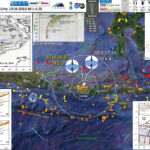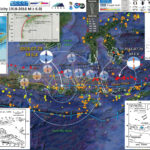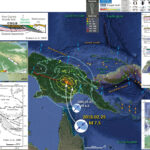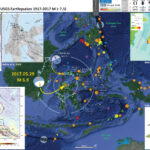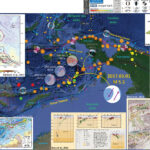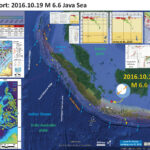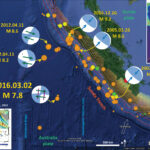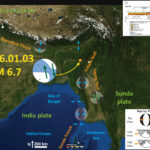Yesterday morning, as I was recovering from working on stage crew for the 34th Reggae on the River (fundraiser for the non profit, the Mateel Community Center), I noticed on social media that there was an M 6.9 earthquake in…
Earthquake Report: Lombok, Indonesia
Earlier today there was a shallow M 6.4 earthquake with an epicenter on the island of Lombok, Indonesia. With a hypocentral depth of about 7.5 km, this size of an earthquake can be quite damaging. The USGS PAGER estimate of…
Earthquake Report: Papua New Guinea
This morning (local time in California) there was an earthquake in Papua New Guinea with, unfortunately, a high likelihood of having a good number of casualties. I was working on a project, so could not immediately begin work on this…
Earthquake Report: Bengkulu (Sumatra)!
Last night (my time) while I was tending to other business, there was an earthquake along the Sunda Megathrust. Here is the USGS website for this M 6.4 earthquake. This M 6.4 earthquake happened down-dip (“deeper than”) along the megathrust…
Earthquake Report: Sulawesi, Indonesia
There was a series of earthquakes in Sulawesi, Indonesia earlier today, with a mainshock having a magnitude of M 6.8. This series of earthquakes is interesting as it does not occur on the main plate boundary fault, but on upper…
Earthquake Report: Banda Sea
Earlier this week there was a moderate earthquake along a strike-slip fault that appears to adjoin the Banda/Timor/Java Arc with New Guinea. This strike-slip fault appears to cross oblique to the subduction zone that forms the Timor Trench to the…
Earthquake Report: Java Sea!
Last night as I was finishing work for the day, I noticed an earthquake in the Java Sea, just north of western Java. Here is the USGS website for this M 6.6 earthquake. This earthquake is extensional and plots very…
Earthquake Report: South Bismarck Sea
There was a moderately deep earthquake in the South Bismarck Sea last night. Here is the USGS website for this earthquake. This earthquake has an exentional earthquake. Here, the Solomon Sea plate subducts northward beneath the South Bismarck plate to…
Earthquake Report: Sumatra!
We just had a M = 7.8 earthquake southwest of the Island of Sumatra, a volcanic arc formed from the subduction of the India-Australia plate beneath the Sunda plate (part of Eurasia). Here is the USGS website for this earthquake.…
Earthquake Report: India!
Today we had a good sized earthquake in eastern India, within the India-Burmese wedge (IBW). The IBW is a part of the convergent plate boundary between the India plate to the west and the Burma (part of Eurasia) plate to…
